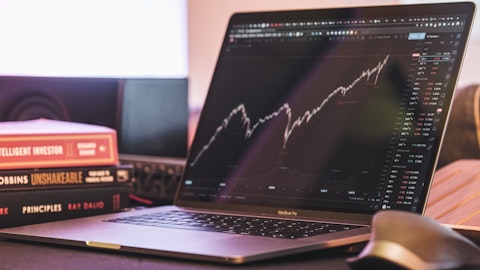1. Amazon.com, Inc. (NASDAQ:AMZN)
Number of Hedge Fund Holders: 273
Total Value of Hedge Fund Holdings: $51.5 Billion
Topping the 15 best American stocks to buy now is Amazon.com, Inc. (NASDAQ:AMZN). The Washington-based multinational technology company has over 150.6 million users. During the COVID-19 pandemic, Amazon.com, Inc. was one of the best American stocks that thrived. The company managed to stay afloat with an increase in online sales, specifically for products to protect against the virus, office supplies, and fitness gear. From February-March, toilet paper purchases on Amazon increased by 186% year-over-year, while cough and cold medicine sales increased by 862%.
Amazon.com, Inc.’s (NASDAQ:AMZN) net income came in at $8.1 billion in the first quarter of 2021, up from $4.0 billion in the first quarter of 2020. Shares of AMZN surged 32% over the last three months. On May 12, Citigroup held its Buy rating on AMZN and raised the price target to $4,175.
There were 273 hedge funds that reported owning stakes in Amazon.com, Inc.’s (NASDAQ:AMZN) at the end of the fourth quarter, up from 245 funds a quarter earlier. The total value of these stakes at the end of Q4 is $51.5 billion.
Hayden Capital mentioned Amazon.com, Inc.’s (NASDAQ:AMZN) in its Q1 2021 investor letter:
“Amazon (AMZN): We sold our last remaining stake in Amazon this quarter. Amazon was our longest-running investment holding, after having originally purchasing it at the inception of Hayden in 2014, at a price of ~$317.
I gave some details of how Amazon has progressed over these past 6.5 years in last year’s Q2 2020 letter, which partners can find here (LINK). The company has executed amazingly well over this tenure, with revenues up ~3.3x and since our initial purchase, and reported operating income up ~30x over that period.
Generally, I believe there are three reasons to sell an investment: 1) we recognize our initial thesis is wrong (sell out as quick as possible), 2) we have a significantly higher returning opportunity to redeploy the capital into (sell-down to fund the new investment), or 3) the company is maturing and hitting the top part of it’s S-curve / business lifecycle, so the business has fewer places to reinvest its capital internally. As such, the future returns will likely be lower than the past. This investment thus becomes a “source of capital” in the future, as we fund earlier-stage investment opportunities.
In the case of Amazon, we decided to sell due to the third scenario. I’m sure Amazon will continue to generate value for shareholders and continue to keep pace with the broader technology sector. However, I’m just not confident it’s as attractive an investment as when we first invested.
With ~51% of US households having an Amazon Prime account (and with very low churn), each of these households continuing to increase their annual spend with Amazon, and few / no real competitors in sight, Amazon is a dominant force that will only continue to accrue value as consumers continue to move from offline to online purchases for their everyday needs. Likewise, the “cash-flow machine” of Amazon Web Services is in a similar position of strength, with AWS now having ~32% market share and continuing to grow at +30% y/y. Because of this, I think Amazon is probably one of the safest investments in the technology sector today.
So why did we decide to sell the investment then? Simply put, Amazon is in a much different place than when we initially invested. Back in 2014, investors were starting to question whether Amazon’s promise of future earnings potential would actually come to fruition.
Operating income had declined from ~$1.4BN in 2010, to ~$676M in 2012, to just ~$178M by the end of 2014. Expenses were outpacing revenue growth, and investors were questioning whether Amazon’s expenses were truly “investments” as they claimed, or whether it was a structural necessity of the business and thus would never flow to investor’s bottom line.
The critical question was ‘what portion of expenses are truly growth investments vs. structural expenses, and as a result, will Amazon ever be capable of generating significant profits?’
Our analysis indicated that these expenditures truly were the former, and led to the belief that the business’ structural margins would inevitably increase over time. This was our differentiated insight / investment edge.
Fast-forward to today, and our thesis proved correct with operating margins having increased from ~0.2% to ~6%. However due to this success and proving this facet out to investors, Amazon investors have much higher confidence and a better understanding of the company today. I’m not sure we have the same level of differentiated insights, as we did back then.
In addition, I believe the departure of Jeff Bezos and his long-time lieutenants signal a regime change. Perhaps it’s now “Day 1.5” instead of the Day 1 mentality that made Amazon so successful (LINK)… The departures within the past couple years include:
• Jeff Bezos – Founder, CEO, Visionary. Started Amazon in 1994.
• Jeff Blackburn – Joined Amazon in 1998. Oversaw Amazon Marketplace, Advertising,
Amazon Studios, Prime Video, Prime Music, M&A.
• Jeff Wilke – Joined Amazon in 1999. Oversaw Amazon Consumer (ecommerce)
business.
• Steve Kessel – Joined Amazon in 1999. Oversaw Physical Stores, Kindle, and Whole
Foods.
Blackburn, Wilke, and Kessel have each arguably created hundreds of billions of shareholder value. On top of this, Bezos is the visionary and culture-setter behind Amazon. When he and his long-time lieutenants take their hands off the wheel, it is probably time for us to as well.
We sold our remaining shares at an average price of ~$3,240. Based on our initial investment, we made a ~10x return in a little over six years, for a ~45% IRR7. We reinvested the proceeds into our existing portfolio, taking advantage of the prices offered by this latest market draw-down.”
You can also take a peek at 10 Best Travel Stocks to Buy Right Now, and 10 Best Automotive Stocks to Invest in Now.




